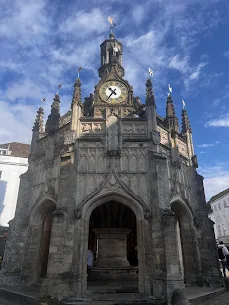Chichester is the only city in West Sussex, mostly due to historical
reasons - it's much smaller comparably to Crawley, coming in at 30,000
people. It became a city in the 11th century, during the rule of King
Stephen, though had previously been settled for nearly a thousand years
before. It's a lovely place, one I was able to visit for only an hour before
going back home. As a result, I only looked at the town centre.
The parking spaces were right by the old Roman wall, which were constructed in the 4th century AD Britain. Chichester was founded in the 1st century AD, initially as a military base, with the settlement of Noviomagus Reginorum standing here, connected to London by Stane Street (now mostly the A24). It was ruled by the Celt King Cogidubnus, who lived in the nearby settlement (and now archaeological goldmine) of Fishbourne, and who lives on in Latin school textbooks. Not much of it remains, but the wall continues standing - initially keeping invaders out, it now blends in nicely with the rest of the city centre.

After the Romans left, Chichester slowly grew into a market town under Saxon and then Norman rule, before it became a city. Around this time, it also became the home of Chichester Cathedral, which was consecrated in 1108. It came about after the Bishop of Selsey moved to Chichester in 1075, and the cathedral was built to replace the old Selsey Abbey which used to be the seat of the bishop. The cathedral has been repeatedly rebuilt due to damage, notably when its spire collapsed in 1861, yet stands proud to this day. It's wonderful inside as well, though I didn't take any photos. I believe a service was due to begin, this being a Saturday, and I didn't take enough time to look around and admire its ornateness.

Outside the cathedral, by the grassy plain dotted with tombstones, is a copper-green statue of St Richard, who was the Bishop of Chichester in the 13th century. He spent his life being the chancellor at Oxford University, helping the poor and renouncing corruption, before being canonised in 1262. His grave became a shrine and pilgrimage destination, before Henry VIII destroyed it several years later during the Reformation. He remains honoured through Sussex Day, which is held on his feast day.

Chichester Cross stands at the junction to the high street, and it's rather stunning. It was built in the 16th century to enable poorer people to trade without paying a toll, provided they did so under the cross. Its original purpose has long since been usurped - there were even plans to demolish it in 1808 - and it's now a delightful icon of the city. It's covered with ornate clocks, installed in 1746 (replacing a series of original clocks from 1724), and is intricately decorated. People were resting inside, admiring the structure, or walking past if they were particularly accustomed to it.

The high street itself is rather standard - it was quite empty, with it being rather early in the day. It's less a high street, more a collection of streets named for compass directions, the Cross in the middle. There was a busker playing with a skeleton-shaped robot, however. A stack of CDs by his side, he was playing a bluesy guitar whilst the skeleton hit away at the drums, which made for a unique performance and I regret not throwing a coin in his hat.
I didn't visit more of Chichester, as I said I only had an hour to spend, so going down to the harbour or towards the local university wasn't an option. There wasn't time to visit Chichester station, part of the (repeatedly mentioned on this blog) London, Brighton and South Coast Railway, either.
Chichester is a wonderful city to visit if
you have some time to spare, it's worth every minute, and I'm sure the
surrounding greenery is fantastic too.

Comments
Post a Comment